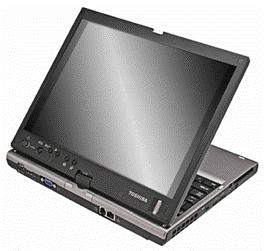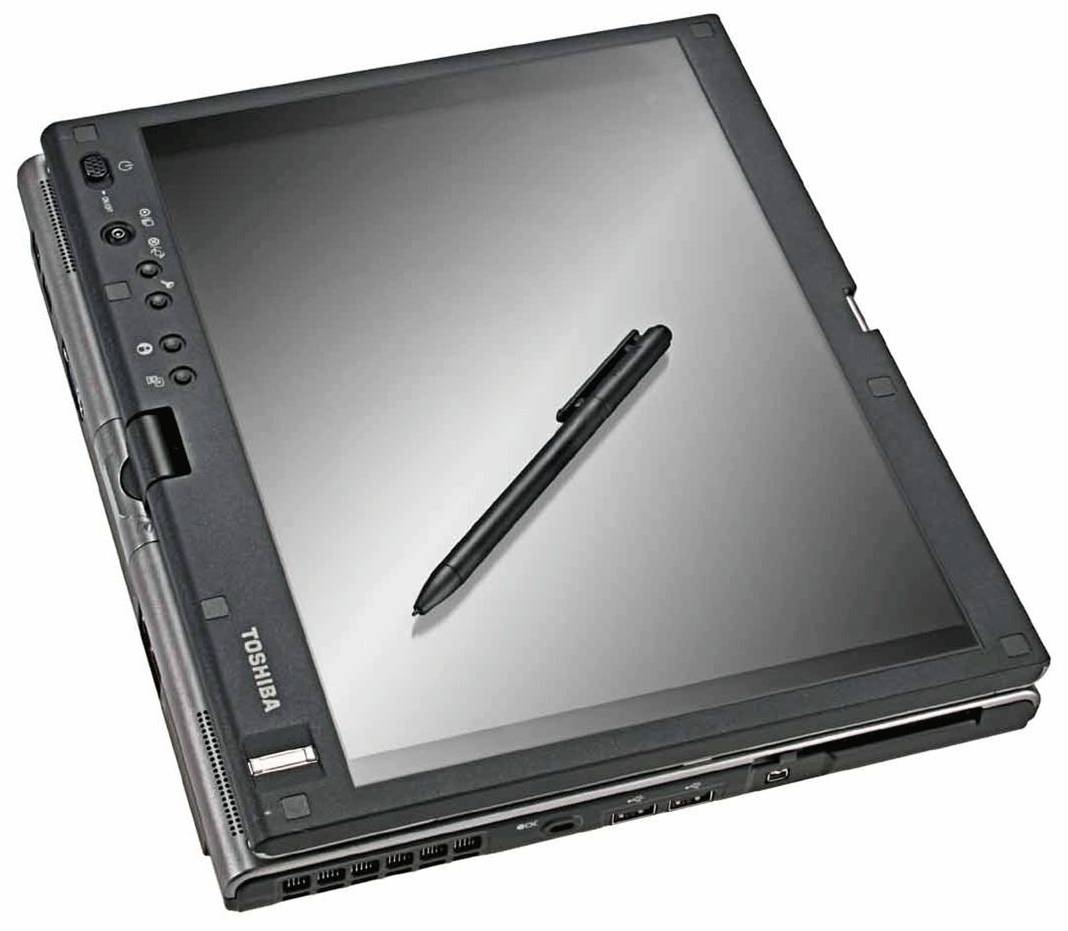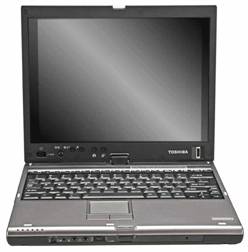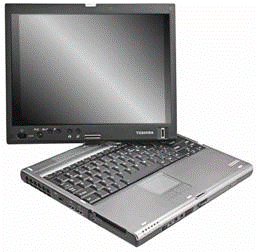« Make your PPC Phone Ring & Sing | Main | A Peculiar 2 GB SD/USB Expansion Card »
September 28, 2006
Toshiba Portege Duo Core M400 Tablet PC
My very first laptop was a Toshiba, and was I ever proud of it. It had not one, but TWO 3.5 inch floppy drives and a sizzling 900 baud modem. I was the envy of everyone, and I was smugly convinced that I possessed the pinnacle of laptop computing. If someone had told me my treasured Toshiba would eventually morph into an M400 Tablet PC with a duo core processor with Wi-Fi, Bluetooth, XGA color display, stereo sound system, SD card reader, 60 MB hard drive, with a 56K modem, I probably wouldn't have understood half of it, and I probably would have said, "Yeah, but it doesn't have two floppy drives." I have since owned six or seven Toshiba laptops, and it has been interesting and gratifying to see the evolution.

Before going any further, here's a list of major specs for the new M400:
Spec list
Intel Core Duo Processor T2400 (1.83GHz, 2MB L2, 667MHz FSB)
Microsoft Windows XP Tablet PC Edition 2005
512MB PC5300 DDR2 667MHz SDRAM (512MBx1)
12.1" Diagonal Wide View Angle XGA Display (1024x768)
SigmaTel STAC9200 integrated audio, 2 x speakers
Intel Graphics Media Accelerator 950 with 8MB-128MB dynamically allocated shared graphics memory
60GB HDD (5400rpm, Serial-ATA) CD-RW/DVD-ROM Multifunction drive
1 x Type II PC Card slot
Card Reader SD, MMC, MS, MS Pro, xD
Ports 3 X USB, FireWire, RJ11 (modem), RJ45 (Ethernet). VGA out, S-video
jacks mic-in, earphone-out
Intel PRO/Wireless 3945ABG (802.11a/b/g)
Integrated Bluetooth
Ethernet 10/100/1000
Modem 56K data/fax
Weight 4.5 lbs.
6-cell Lithium-ion Battery (rated @ 5 hours) Mfr-claimed battery life 5.1 hours

Software
Of course, Microsoft XP for Tablet PCs comes installed on the machine. In addition, the M400 comes with a generous set of software installed so that you can start working right away. For most people, the selected software is adequate. I am particularly fond of OneNote and keep it running at all times to jot down ideas, take notes, phone messages, outline projects, and more. The beauty of it is that the entire file is searchable and very handy for finding information on a quickly jotted note from months ago. Of course, you input to One Note via handwriting that you can convert to text, or you input from the keyboard. Plus, you can use all the Tablet functionality such as drawing, and you can import multimedia for inclusion in a document.
While it doesn't come with Microsoft Office, it does offer Microsoft Works, which I've never used before. However, upon further investigation, Works certainly offers a useful suite of applications that cover normal office tasks such as word processing, spreadsheets, databases, presentations, graphics, and desktop publishing. Most of the programs seem to have the ability to import and export documents in popular formats so that compatibility is not a serious issue.
On the multi-media front, you get InterVideo WinDVD, InterVideo WinDVD Creator 2 Plantinum, Sonic Solutions Record Now!
Protector Suite software handles the unique bio-security finger print feature. With this feature installed, you must swipe your finger against the reader to gain access to your computer for added security from the outset. If you have some peanut butter on your finger and it misreads your print, it will start wailing like a prison break siren and could embarrass you in public.
There are some nice Toshiba utilities too, such as Remote Camera that allows you to crank out photos while your cellphone or camera is connected to by Bluetooth. The RAID Console allows you to insert a second hard drive instead of the optical drive. Toshiba Assist helps with Bluetooth connectivity. I'm not going to give any publicity to any of the other trail applications that probably change from unit to unit.
Physical features
Some marketing geniuses have discovered that you can sell more technology if it is pink to make it gender oriented. Personally, I don't want to appear to be legally blond and prefer a no-nonsense business-like silver and black appointed machine like the M400.
Let's take a walk around the block to review the various features starting with the bottom of the screen. From left to right, there is a power on/off slider button, a handy, little, thumb joystick useful in tablet mode, an escape/rotate screen button, Ctrl/Alt/Del button, Toshiba Assist Button, Zoom button, and on the far right a fingerprint reader. At the top of the screen is a male latch that swivels 180 degrees to accommodate laptop/tablet screen modes.
On the review unit I received, the D navigation button did not function at all. I would also appreciate at least some up and down scroll buttons for navigation when reading an eBook or a Website.
On the front of the computer from left to right, you will first notice a set of six LED lights in various colors to indicate the status of AD/DC power, power on/off, battery 1, battery 2, HDD activity, wireless activity. Below and to the left of the light panel there is a wireless on/off switch, audio input, audio output, and a volume wheel, followed by the screen latch button. There are two hardly noticeable external microphones on the left and right sides of the front panel.
Moving to the left side, you will find two USB ports, a firewire port, and a PMCIA slot. The fan exhaust is on the far left, and I just say that the fan is quiet and unobtrusive compared to the din of some units I've tested.
On the right side, you will find a silo for housing the digital cyberink pen, a CD/DVD R/W drive, and a combo SD, XD, Memory Stick card reader. I miss the dual CF/SD slots featured on the earlier Toshiba Porteges. The first thing I noticed in hefting the M400 was that it was noticeably heavier than its predecessor. When I spotted the optical drive, I understood immediately. I'm of mixed opinion on the inclusion of this feature. While it certainly adds weight, there have been times when it would have come it handy, and it's a bother to tote an external drive. I expect Toshiba had many requests to include a built-in drive, and that’s why it's there.
Let's take a look at the bottom of the unit where you'll find a battery access panel and the docking station port. Toshiba has added a really cool little surprise feature. It’s a secret panel that contains a mini stylus/cyberpen for emergencies when you’ve lost, misplaced, or used your full-sized one for a swizzle stick. The only problem was that it was missing from the review unit I received.

Miscellaneous test drive comments
After using the M400 on my annual summer sojourn covering over 10,000 miles on the road during which time I test various applications and equipment that keep me productive, entertained, and connected, I officially adopted the M400 as the mother ship to which I attached and tested all manner of peripherals.
The first thing I noticed was the improvement in screen quality. In older Portege units, you had to have the screen adjusted at just the right angle depending on the light to get a clear view, and the side view was foggy. I often enjoy working outside while traveling or in my garden. The M400 amazed me with the clear difference and viewability in outdoor light.
The 12.1" Diagonal Wide View Angle XGA Display (1024x768) screen display is bright, clear, and crisp. The side view has improved immensely too, which means that you have to watch out if you don't want seatmates on the plane to read your screen.
I'm neither an addicted nor a professional gamer, but I do enjoy the occasional round of Age of Empires, which requires a pretty fair amount of hunk to perform smoothly, and I have no complaints with the Intel 128 MB video card, which I thought might not be too powerful, but the duo core seems to take care of the problem.
It also makes a great DVD movie viewer. My wife and I call it belly vision because we are fond of watching movies on it in bed in hotel rooms while traveling. You can also escape paying for movies on planes, if you're toting an M400.
I don't know about you, but one of the things that annoys me no end is when I turn on my laptop and McAfee starts scanning for viruses and downloading updates, which can sometimes bring your machine to its knees during the lengthy process. This is particularly perturbing when you have limited time between flights and need to check your email and respond. Sometimes I think McAfee itself is worse than having a virus. Anyway, I did not even notice that this process was going on with the M400 because one side of the duo core handled it while the other was free for personal computing.
After getting used to packing an external drive for several years now, I thought it was preferable to the increased weight of an internal drive. But, after living with the M400 for the summer, I have decided that I would prefer the convenience of an internal drive, even if it adds a little weight.
I had a couple of occasions to share the finger print feature, one with some police officers and another with a group of lawyers. Both were intrigued, not only from the security aspect put from the law enforcement and evidentiary point of view as well.
Working outdoors and traveling on planes gave me a chance to live with the battery life of the M400, and while acceptable, could be better. I'd advise an extra or extended life battery while traveling. Using the machine full bore I could not depend on much more than 1.5 to 2 hours of battery life. But, with just casual use I could log up the five hours.
While writing, I'm fond of listening to satellite music stations via the Internet. While the built-in speakers were good enough for a phone conversation, they do not enhance the music listening experience. For that, I plugged in a Panasonic NXT flat panel speaker system, and the world came alive with the sound of music.
During my summer sojourn, I used the M400 as a GPS guidance system with the help of Microsoft Streets and Trips, Co-Pilot Live, and satellite receivers. It worked like a charm and gave me a much broader perspective than a heldheld device. The proof is that it brought me back home safely without getting lost so I could write this review.
By the way, I believe in VoIP to the max and found that the M400 performed seamlessly using Skype. I just sat in front of it and talked in a normal voice. The mics picked it up without any complaints on the receiving side. I could hear people almost as clearly as if they were in the same room. This machine is a pleasure to use for telephonic communications.
Docking Station/Port Replicator
An optional docking platform is available for the M400. Designed to work with the M405 as well, it is adjustable. Only slightly bigger that the M400 footprint, it measures 12"x12". It sits flat with a slight incline with the rear of the dock raised less than an inch. You can easily lock the M400 in place to gain a few added features such as four more USB ports, an on/off power switch, AC charging, two video ports, and a LAN port. It is primarily designed to create a desktop-like environment.
Compared to the docking station available for the M200, this one pales in comparison. The M300 dock swivels from landscape to portrait and has a built-in optical drive plus, some extra ports and a PMCIA port. What I like about it is that you can also adjust the vertical angle of the screen. I'm not sure the M400 is worth an extra $200, at least not in my world.

The main value of the docking station is that you can leave the cable connected and you don't have to reconnect them every time you set up your M400.
My Mother Ship
The M400 was a welcome, powerful, compact travel companion and mother ship for tethering all my peripherals. Its onboard CD/DVD R/W optical drive makes a great DVD viewer. As stated above, my wife and I call it "belly vision" because we like to watch it in bed. You can save money on airplane flights by watching your own DVDs. I also enjoyed using it to grab and play MP3 music. It makes a super VoIP telephone too with built-in microphone and stereo speakers—you can call around the world free computer to computer over the Internet. Grandkids liked watching cartoons, playing games, and drawing on it. It's sort of an expensive toy though at $1600, but an inexpensive business tool. You can spend over $2200 for the fanciest M400-S4032 that comes with 3G WAN for wireless productivity, connect anywhere feature that allows cell phone calls. The prices have dropped $1000 since the advent of the first Tablet PC just three years ago.
Conclusion
In the final analysis, the M400 has spoiled me, and I cannot even imagine life without a duo core processor, the crisp display, and never-ceases-to-amaze-me Tablet functionality. I am happy to give the Toshiba Portege M400 my very highest recommendation. It has come a long way from dual floppies to duo core, and I wonder where it will possibly be in ten years. It is a bargain at about $1600, considering the technology packed into it. For now, it is clearly a state of the art machine worthy of your close attention, especially if you are a mobile professional or a student in need of versatile but compact computing power on the go. Hey, it works great for couch potatoes too, which I can say with some authority because I live in Idaho.

Posted by tim at September 28, 2006 12:40 AM







